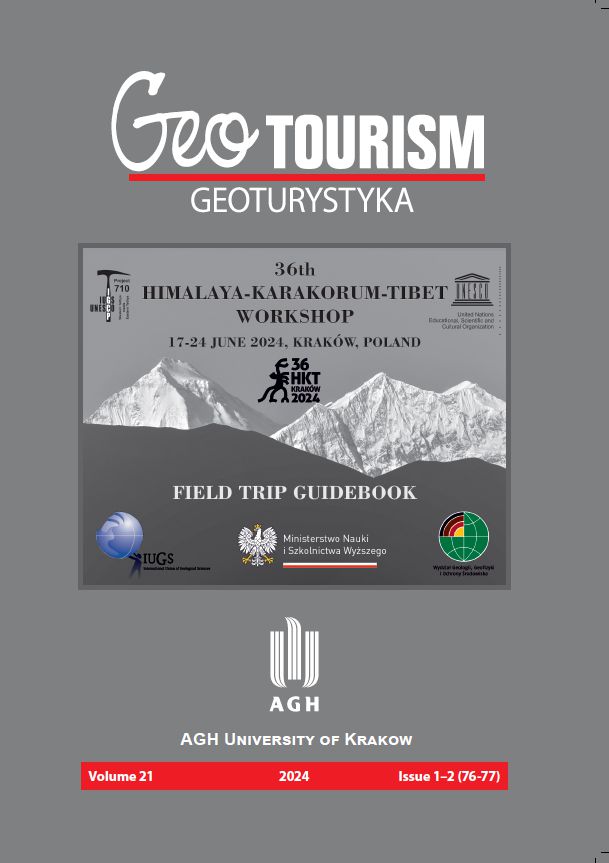Field trip – Outer Flysch Carpathians, Pieniny Klippen Belt (PKB), and Tatra Mountains
DOI:
https://doi.org/10.7494/geotour.2024.1–2%20(76–77).5Abstrakt
The 36th HKT Workshop (Himalaya-Karakorum- Tibet) is organised by the AGH University of Krakow, Poland. Kraków is situated at the front of the Carpathian orogenic system of the ancient Tethys Ocean and is perfect place for meeting between European-Asian Alpine-Himalayan orogenic belt with long history of the Western and Eastern Tethyan Ocean Realms. The 36th HKT Workshop concerns mainly on this first area and the meeting will be focused on Himalaya-Karakorum-Tibet regions but will be also concentrated (especially during field trip) on comparison between Asian (eastern) and European (western) parts of orogen and geotectonic events based on research of different branches of geology: stratigraphy, paleontology, sedimentology, paleogeography, structural geology, petrology, geochemistry, paleomagnetism, and geophysics. The 36th HKT Workshop is aimed to provide a forum for colleagues from America and Asian/European countries, to present their work and discuss their ideas covering various aspects of the development of the Eurasian Alpine history. We are glad that we can meet personally during the 36th HKT Workshop after the pandemic time, which disrupted our idea of regular, annual meetings. Simultaneously we are under IGCP 710 Project logo (Western Tethys meets Eastern Tethys – geodynamical, paleoceanographical and paleobiogeographical events), and we have now the chance to discuss face to face and go to the field together to touch Carpathian/“Tethyan” rocks for a better understanding of what happened hundreds/decades of millions years ago in our lovely ancient ocean. As you know, through your knowledge and experience, the Tethyan Ocean history, both in its western and eastern parts, is fascinating, but enigmatic from time to time, to say the least. Generally, the geological history of the Tethys Ocean
is broadly established. Yet many details are still unknown and many major questions remain, related to geotectonics, palaeogeography, palaeoceanography and palaeobiogeography. Improved understanding of the Mesozoic-Cenozoic ocean/climate history is based on accurate reconstruction of the distribution of continents and ocean basins and on opening and closing of seaways along the Tethys. There is little or no agreement about the number or size of separate basins, nor on their space-time relationships. Moreover, there is no consensus on the number and location of former microcontinents and on their incorporation into the present-day Eurasian-Mountain Belt. Geologists studying individual parts of these belts have been educated within different geological systems and adhere to different geological paradigms. Correlation between Western and Eastern Tethys is difficult, not only because of the large distances involved, but also because they are separated by the area of the huge Himalayan collision within which much of the pre-Paleogene tectonostratigraphic information has been lost. On the one hand, UNESCO forms a special umbrella for the IGCP Projects, and on the other hand, it has been very active in supporting the ideas of “geoparks” and “geotourism” for years. For this reason, we decided to use an international magazine – “Geotourism” – to print the field trip guidebook [“Geotourism”, 2024, 76–77(1–2)]. We hope it will be useful for both Alpine-Himalayan/Tethyan friends and geotourism enthusiasts. Enjoy Kraków during the stationary part of the 36th HKT Workshop and the Polish-Slovak-Czech Carpathians during a 5-day field trip!
##plugins.generic.usageStats.downloads##
##submission.downloads##
Opublikowane
Jak cytować
Numer
Dział
Licencja
##submission.license.cc.by3.footer##
Ten utwór jest dostępny na licencji Creative Commons Uznanie autorstwa 3.0 Unported.


